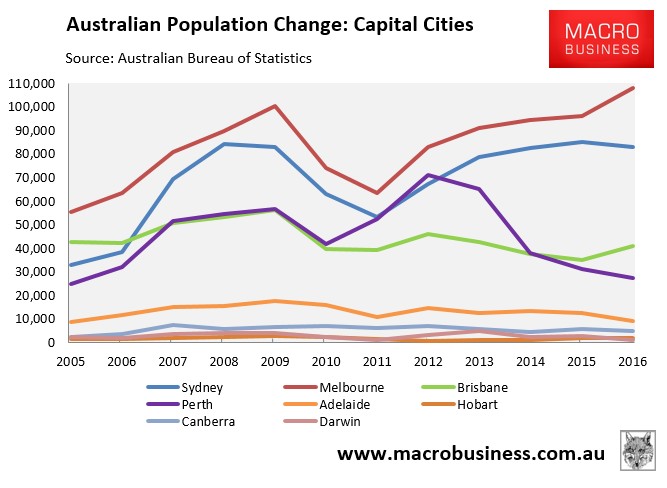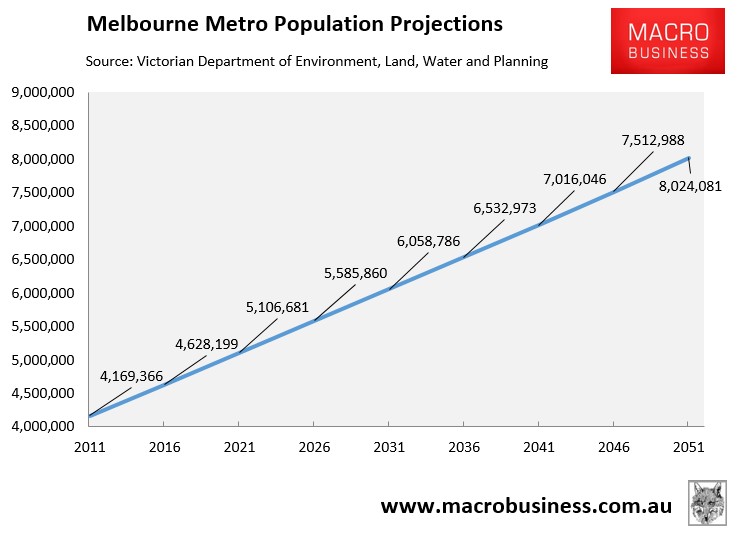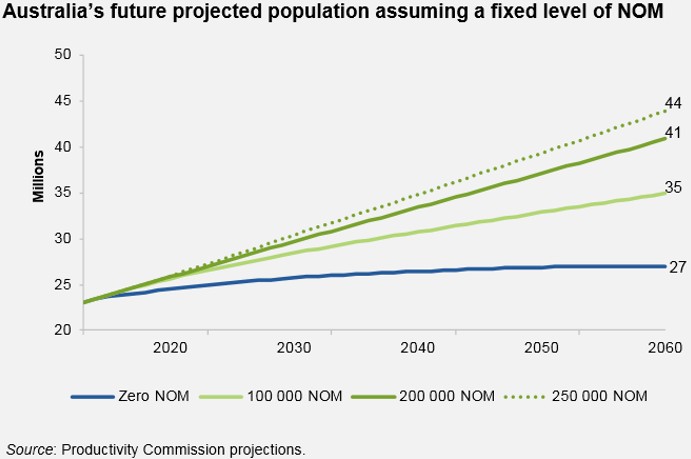Let’s take a walk down memory lane. It’s 2002, Melbourne’s population is 3.5 million, and the Victorian Government has just released its long-range planning blueprint “Melbourne 2030: Planning for Sustainable Growth”, which “despite a slowdown in population growth” aimed to fit an extra one million people into Melbourne by 2030.
Now let’s fast forward to June 2016 – the latest available population data for Melbourne. Melbourne’s population has expanded the most in the country, adding more than 1.1 million people (a 32% increase) since Melbourne 2030 was released, or roughly 82,000 people a year:

Melbourne’s population growth has been anything but “sustainable”, with Melbourne 2030’s one million population growth target breached in less than half the projected time.
Instead of projecting “sustainable” growth in the future, the Victorian Government has instead released new population projections, which have Melbourne’s population growing by 97,000 people per annum over the next 30 years to more than 8 million by 2051:

Late last year, Infrastructure Victoria warned that Melbourne is facing eternal gridlock as its population soars way beyond the capacity of the road system:
Melbourne is set to become so choked by cars in coming decades that the average speed during the morning peak will drop to just 31 kilometres an hour – even with billions of dollars of planned road and rail upgrades.
In a depressing analysis of the challenges facing Australia’s fastest growing city, Infrastructure Victoria bluntly warns it will be impossible for Melbourne to build its way out of congestion…
As it is, about 30 per cent of car trips today happen on congested roads during the morning peak.
But by 2046, the number of daily trips made on the transport network is expected to soar by 74 per cent…
It said within 15 years, delays caused by traffic snarls will be costing every Melburnian an average of $1700 a year more than under a scenario where traffic could move more freely…
He said it would be impossible for Melbourne to build its way out of the problem, given the rate of population growth.
Ernst and Young also forecasts that tram speeds would grind to a halt:
Slow tram speeds caused by increased congestion on the roads is a growing problem – trams travel at average speeds of 15.7 km/h now, down from 17.2 km/h in 2012, the report says…
“The forecast population growth and changing employment patterns in Melbourne will change transport demand, placing considerable strain on our public transport system, as people become less reliant on car ownership and increasingly look to public transport to meet their evolving travel needs,” the report predicts.
In response, the Victorian Government has released an absurdly thin plan to combat Melbourne’s population growth, including all of the usual stuff such as:
- Some new infrastructure projects, such as a $10 billion “Missing Link” road in the north-east and a $5 billion rail line to Melbourne Airport as priority projects for completion within the next 15 years.
- The introduction of a congestion tax to reduce road demand and forestall the need for more infrastructure investment. The report claims that around 20% of car trips between 7am and 9am are not related to work or education.
- Denser development in areas where infrastructure is already well established, including Melbourne’s eastern and southern suburbs, to stop Melbourne sprawling.
Blind Freddy can see that this infrastructure plan will not stop the slide in Melbournians’ living standards. We have seen similar plans released over the past decade or so, and not much ever changes. The city’s population continues to balloon and infrastructure never catches up, as admitted by Infrastructure Victoria.
The Productivity Commission revealed in its recent Migrant Intake Australia report that immigration policy is a defacto population policy. If our policy makers choose to persist with a high immigration program then Australia’s population will hit 40 million or more by 2060, with most of this added population flowing to Melbourne and Sydney. However, if Australia cuts immigration back significantly, Australia’s population will be much smaller, as it will be in our major cities:

Indeed, the Productivity Commission estimated a 13 million difference in Australia’s population size in 2060 between persisting with historical rates of immigration (40 million) and zero net overseas migration (27 million).
Given the strains across our big cities, it is patently obvious that the sensible thing to do is to reduce Australia’s net overseas migration to much lower levels than the circa 200,000 average over the past decade. This would unquestionably relieve pressures on congestion, housing, and overall living standards, while forestalling the need for costly retrofitting of infrastructure to accommodate more people.
It is a policy choice how big and crowded Australia’s cities become. We must exercise this choice by cutting immigration significantly and aiming for a smaller, more sustainable and more liveable Australia.
Sadly, only the Sustainable Australia party has our interests at heart and is fighting the good fight.

